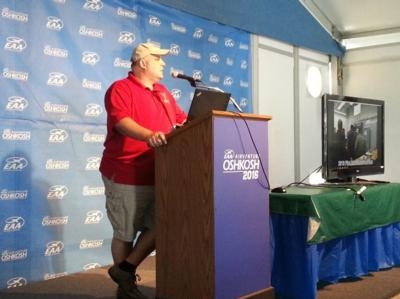Thu, Jul 28, 2016
Presents Update On Milestones Reached At AirVenture
By Anthony Liberatore
Since their first news conference at AirVenture last year, Engineered Propulsion Systems (EPS) has reached several significant milestones on their path towards certification of their Diesel engine.

EPS Co-founder, CEO, and President Michael Fuchs said in a news conference Tuesday that the company has made progress towards both Type (TC) and Production Certification (PC) as well as serial production. Fuchs noted the target date for obtaining a Type Certificate is late 2017, with the PC shortly their after. The EPS Engine is a “Flat Vee” (15º) V8 Heavy Fuel Engine in the 300 to 420 hp class, with fuel consumption specifics that are 30% lower than their Piston competitors and 50% lower than their Turboprop competitors.
Among the milestones noted by Fuchs for 2016 are that the conformity process has proceeded to the point that all engine parts and systems are confirmed. He also noted they have completed their second Propeller Survey with Hartzell Propeller at their Ohio facility. Fuchs also noted that EPS Diesel with be certified for both Composite and Metal Propellers. Early on in EPS's development cycle, EPS met with potential customers from diverse backgrounds such as Missionary Aircraft and Seaplanes to understand what type of propellers were needed for their applications.
Fuchs said the company has ramped up personnel to assist in their efforts towards obtaining their TC and PC, including direct hires, sub-contractors, and those affiliated with their Diesel Injection / ECU system sub-supplier Bosch. At this time, 100 people are working towards both certifications, with the majority of the employees working under the Bosch umbrella.
Fuchs discussed a number of interesting facts about the engine. One is that while it is a 15º V8, the footprint of the engine is that of a traditional flat six cylinder aircraft engine. Another is while it is Liquid Cooled Diesel, there are not aviation fluids available for both systems. However, the engine will utilize the conventional 50/50 coolant and water mix for the liquid cooling system and a heavy duty Diesel truck oil for its lubrication. Fuchs was asked about testing the engine's ECU against potential lightning strikes, and he said the company is working towards meeting DO-160G, FAR 23, and FAR 27 requirements for the ECU.
(Staff image)
More News
Circle To Runway (Runway Number) Used by ATC to inform the pilot that he/she must circle to land because the runway in use is other than the runway aligned with the instrument appr>[...]
Aero Linx: National Aviation Safety Foundation (NASF) The National Aviation Safety Foundation is a support group whose objective is to enhance aviation safety through educational p>[...]
At Altitude Of About 250-300 Ft Agl, The Airplane Experienced A Total Loss Of Engine Power On November 6, 2024, at 1600 central standard time, a De Havilland DHC-1, N420TD, was inv>[...]
From 2009 (YouTube Edition): Three Hour Flight Was 'Flawless' -- At Least, Until Mother Nature Intervened For anyone who loves the aviation business, this was a VERY good day. Afte>[...]
Also: AMA Names Tyler Dobbs, More Falcon 9 Ops, Firefly Launch Unsuccessful, Autonomous F-16s The Air Force has begun ground testing a future uncrewed jet design in a milestone tow>[...]
 ANN's Daily Aero-Term (05.05.25): Circle To Runway (Runway Number)
ANN's Daily Aero-Term (05.05.25): Circle To Runway (Runway Number) ANN's Daily Aero-Linx (05.05.25)
ANN's Daily Aero-Linx (05.05.25) NTSB Prelim: De Havilland DHC-1
NTSB Prelim: De Havilland DHC-1 Classic Aero-TV: The Boeing Dreamliner -- Historic First Flight Coverage
Classic Aero-TV: The Boeing Dreamliner -- Historic First Flight Coverage Airborne-NextGen 05.06.25: AF Uncrewed Fighters, Drones v Planes, Joby Crew Test
Airborne-NextGen 05.06.25: AF Uncrewed Fighters, Drones v Planes, Joby Crew Test



